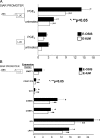Prostaglandin E2 via steroidogenic factor-1 coordinately regulates transcription of steroidogenic genes necessary for estrogen synthesis in endometriosis
- PMID: 19001523
- PMCID: PMC2646521
- DOI: 10.1210/jc.2008-1180
Prostaglandin E2 via steroidogenic factor-1 coordinately regulates transcription of steroidogenic genes necessary for estrogen synthesis in endometriosis
Abstract
Context: Products of at least five specific steroidogenic genes, including steroidogenic acute regulatory protein (StAR), which facilitates the entry of cytosolic cholesterol into the mitochondrion, side chain cleavage P450 enzyme, 3beta-hydroxysteroid-dehydrogenase-2, 17-hydroxylase/17-20-lyase, and aromatase, which catalyzes the final step, are necessary for the conversion of cholesterol to estrogen. Expression and biological activity of StAR and aromatase were previously demonstrated in endometriosis but not in normal endometrium. Prostaglandin E2 (PGE2) induces aromatase expression via the transcriptional factor steroidogenic factor-1 (SF1) in endometriosis, which is opposed by chicken-ovalbumin upstream-transcription factor (COUP-TF) and Wilms' tumor-1 (WT1) in endometrium.
Objective: The aim of the study was to demonstrate a complete steroidogenic pathway leading to estrogen biosynthesis in endometriotic cells and the transcriptional mechanisms that regulate basal and PGE2-stimulated estrogen production in endometriotic cells and endometrium.
Results: Compared with normal endometrial tissues, mRNA levels of StAR, side chain cleavage P450, 3beta-hydroxysteroid-dehydrogenase-2, 17-hydroxylase/17-20-lyase, aromatase, and SF1 were significantly higher in endometriotic tissues. PGE2 induced the expression of all steroidogenic genes; production of progesterone, estrone, and estradiol; and StAR promoter activity in endometriotic cells. Overexpression of SF1 induced, whereas COUP-TFII or WT1 suppressed, StAR promoter activity. PGE2 induced coordinate binding of SF1 to StAR and aromatase promoters but decreased COUP-TFII binding in endometriotic cells. COUP-TFII or WT1 binding to both promoters was significantly higher in endometrial compared with endometriotic cells.
Conclusion: Endometriotic cells contain the full complement of steroidogenic genes for de novo synthesis of estradiol from cholesterol, which is stimulated by PGE2 via enhanced binding of SF1 to promoters of StAR and aromatase genes in a synchronous fashion.
Figures






References
-
- Giudice LC, Kao LC 2004 Endometriosis. Lancet 364:1789–1799 - PubMed
-
- Ryan IP, Taylor RN 1997 Endometriosis and infertility: new concepts. Obstet Gynecol Surv 52:365–371 - PubMed
-
- Sampson JA 1927 Peritoneal endometriosis due to the menstrual dissemination of endometrial tissue into the peritoneal cavity. Am J Obstet Gynecol 14:422–469 - PubMed
-
- Tremblay Y, Ringler GE, Morel Y, Mohandas TK, Labrie F, Strauss 3rd JF, Miller WL 1989 Regulation of the gene for estrogenic 17-ketosteroid reductase lying on chromosome 17cen–q25. J Biol Chem 264:20458–20462 - PubMed
-
- Bulun SE, Cheng YH, Yin P, Imir G, Utsunomiya H, Attar E, Innes J, Julie Kim J 2006 Progesterone resistance in endometriosis: link to failure to metabolize estradiol. Mol Cell Endocrinol 248:94–103 - PubMed
Publication types
MeSH terms
Substances
Grants and funding
LinkOut - more resources
Full Text Sources
Other Literature Sources
Medical
Miscellaneous

